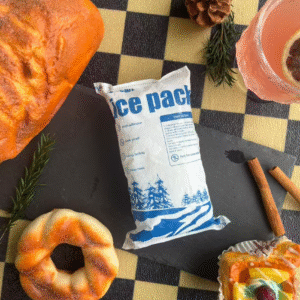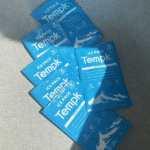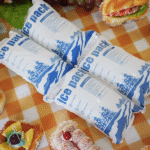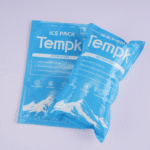Shipping fish, whether fresh, congelado, or processed, requires maintaining an effective cold chain to ensure product quality and safety. Dry ice packs are the go-to solution for many businesses in the seafood industry, thanks to their ability to maintain ultra-low temperatures without leaving behind harmful liquid residue. This guide delves into the advantages, functionalities, and best practices for using dry ice packs in fish shipping, exploring the latest trends and innovations for 2025.
What Are Dry Ice Packs?
Dry ice packs are sheets that contain solid carbon dioxide (Co₂), que sublima a -78,5 ° C (-109.3°F), transitioning directly from a solid to a gas. Ao contrário do gelo tradicional, que derrete na água, dry ice avoids creating moisture that can potentially damage or degrade perishable goods. This unique property makes dry ice an ideal cooling solution for shipping seafood, especially when maintaining frozen or sub-zero temperatures is essential.
Key Benefits of Using Dry Ice Packs for Shipping Fish
Dry ice packs provide a range of benefits that are especially useful in the cold chain logistics of fish shipping:
-
Duração estendida de resfriamento: Dry ice remains effective longer than regular ice. The sublimation process of dry ice allows it to provide continuous cooling for up to 48 horas, making it perfect for long-distance shipments.
-
Sem resíduos: Unlike traditional ice that melts into water and can cause product contamination, dry ice sublimates completely without leaving behind any liquid, ensuring that the packaging remains dry and the products stay clean.
-
Compacto e leve: Dry ice packs are not only efficient but also compact, offering a space-saving solution in shipping containers. This ensures that businesses can maximize the number of shipments per container while keeping the temperature low.
-
Opções reutilizáveis: Some types of dry ice packs can be reused multiple times, contributing to long-term cost savings while also reducing environmental impact through recycling and reusing the packs.
Dry Ice Packs for Different Types of Fish
Dry ice packs are versatile and can be used effectively for various types of fish, each with different temperature requirements:
-
Peixe fresco: These products need to be kept just above freezing to preserve their freshness during transportation. Dry ice can maintain a cool enough temperature to ensure they arrive at the destination without any spoilage.
-
Frozen Fish: Fish that are frozen for shipping require dry ice to keep them at sub-zero temperatures throughout the journey. Dry ice helps prevent thawing and bacterial growth, preserving the fish in its original state.
-
Processed Fish Products: Products like fillets, smoked fish, or other value-added fish products benefit from dry ice as it helps maintain the optimal temperature, preventing deterioration and maintaining quality.
Best Practices for Using Dry Ice Packs in Fish Shipping
To ensure that fish products arrive safely and in top condition, it’s essential to follow best practices when using dry ice packs:
1. Determine the Required Cooling Capacity
Properly calculating the amount of dry ice needed is essential to prevent both undercooling and overspending. A general guideline is to use 5-10 pounds of dry ice for every 15 quarts of cooler space per 24 horas de trânsito. Para remessas mais longas, or if high ambient temperatures are expected, increase the amount accordingly.
2. Use Proper Packaging
Insulated containers are crucial for keeping dry ice packs and fish products at the correct temperature. Packaging materials like expanded polystyrene (EPS) or polyurethane should be used for their thermal resistance. Ensure that the container is sealed, but not airtight, to allow gas to escape and prevent pressure build-up.
3. Layering Technique
Ao embalar, it’s important to use a layering technique to maintain an even temperature distribution:
-
Camada inferior: Start with an insulating layer at the bottom of the container, such as foam or cardboard, to protect the fish from any initial heat transfer.
-
Camada média: Arrange the frozen or fresh fish evenly, avoiding overcrowding. Air circulation between the fish pieces ensures that the cold air can circulate freely, maintaining consistent temperatures.
-
Camada superior: Place the dry ice packs on top of the fish, creating a “cold dome” that ensures cold air sinks and surrounds the products.
-
Fill Void Spaces: To reduce the need for excess dry ice, use crumpled paper or extra insulation to fill any empty spaces, preventing air gaps that could affect the temperature control.
4. Garanta ventilação adequada
Gelo seco sublima em gás co₂, which can accumulate and cause dangerous pressure build-up if the container is sealed tightly. To prevent this, leave small vents or cracks in the container’s lid to allow the gas to escape safely.
5. Follow Safety Regulations
As dry ice is classified as a hazardous material (E 1845), all shipments must comply with transportation regulations. Proper labeling and documentation are required to ensure the safety of handlers and compliance with carrier guidelines. Para remessas aéreas, many airlines restrict the amount of dry ice per package, typically limiting it to 5.5 libras (2.5 kg).
6. Precauções de segurança
Ao lidar com gelo seco, ensure that protective gloves and goggles are worn to avoid frostbite. Dry ice should be stored in well-ventilated areas to prevent CO₂ from accumulating, which could lead to asphyxiation in confined spaces.
7. Disposal of Dry Ice
Once dry ice has been used, it should be allowed to sublimate in a well-ventilated area, away from people or animals. Never dispose of dry ice in sinks, drains, or trash bins, as it could cause damage or pose a safety risk.
Comparative Cooling Methods
While dry ice is often the best choice for frozen fish, other cooling methods such as gel packs and water ice packs are also available. Aqui está como eles se comparam:
| Método de resfriamento | Faixa de temperatura | Duração | Practical Significance |
|---|---|---|---|
| Pacote de gelo seco | -78.5°C (-109.3°F) | 24-48 horas | Best for long-distance frozen fish shipping; Sem resíduos de água, ideal for exports. |
| Pacote de gel | 0°C-8°C (32°F-46°F) | 6-12 horas | Ideal for chilled seafood or short-distance deliveries; reusable and non-toxic. |
| Water Pack | ~ 0 ° C. (32°F) | 6-8 horas | Low-cost option for non-perishable items; melts into liquid and can cause leakage. |
Common Questions About Dry Ice Packs for Fish Shipping
-
How long will dry ice keep my fish frozen?
Dry ice can keep fish frozen for 24–48 hours, depending on the amount of dry ice used, o tipo de embalagem, and the environmental conditions. -
How should I dispose of leftover dry ice?
Always allow unused dry ice to sublimate in a well-ventilated area. Never dispose of it in sinks or trash bins, as this can create dangerous pressure build-up. -
Can I ship live seafood with dry ice?
Dry ice is not suitable for live seafood, as it’s too cold. Use gel packs or water packs to maintain a chilled environment for live seafood.
2025 Trends in Fish Shipping and Cold Chain Logistics
Quando nos aproximamos 2025, several trends are shaping the future of fish shipping and cold chain logistics:
-
Iniciativas de sustentabilidade: Companies are exploring eco-friendly solutions, such as biodegradable dry ice and carbon-capture manufacturing processes, to reduce the environmental impact of their operations.
-
Smart Monitoring and IoT Integration: Real-time temperature tracking using IoT sensors is helping businesses ensure compliance with temperature regulations and improve visibility during the shipping process.
-
Hybrid Cooling Solutions: Combining dry ice with phase change materials (PCM) or gel packs is becoming more common. These hybrid systems offer extended cooling times and reduced dry ice consumption.
Conclusão
Dry ice packs remain an essential tool for efficient and safe fish shipping, providing superior cooling that ensures fish arrive at their destination fresh, congelado, and free from damage. Seguindo as melhores práticas, understanding the cooling requirements, and staying compliant with regulations, businesses can improve the efficiency and reliability of their fish shipping processes.
PRÓXIMOS PASSOS
-
Avalie suas necessidades de remessa: Determine if you need frozen or chilled conditions for your shipments.
-
Calculate Dry Ice Requirements: Use the provided guidelines to estimate the correct amount of dry ice needed for your shipment.
-
Invest in Quality Insulation: High-efficiency containers will reduce dry ice consumption and maintain temperature stability.
-
Stay Informed: Keep an eye on emerging trends such as sustainability and smart monitoring to optimize your cold chain operations.
Sobre Tempk
Tempk is a leader in providing advanced cold chain logistics solutions, specializing in high-performance dry ice packs and insulated packaging for the seafood industry. Our solutions are designed to meet the stringent requirements of modern shipping, ensuring that your seafood products arrive in optimal condition every time.
Entre em contato conosco hoje to learn more about how our dry ice packs can enhance your fish shipping operations.
























